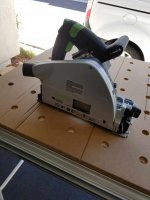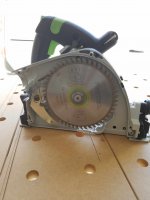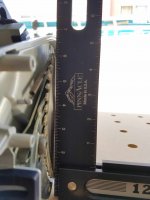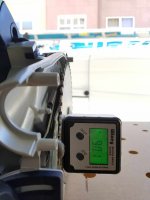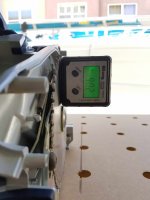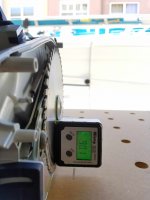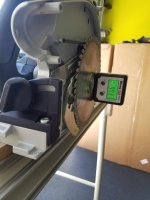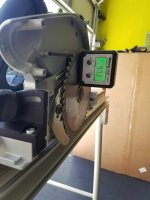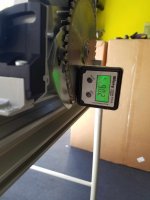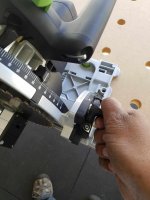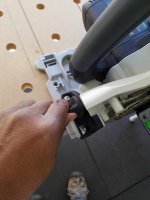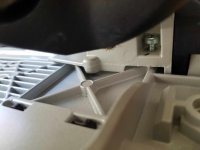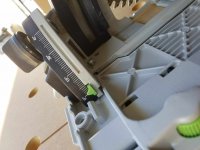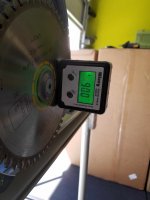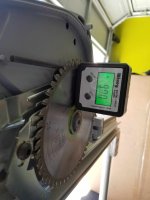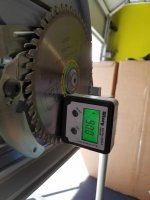insurroundsound
Member
- Joined
- Jul 17, 2008
- Messages
- 45
I have an older TS55 [not the REQ model] and I'm pretty sure I slightly skewed the blade position years ago when I first got the saw. Can't remember what I was TRYING to adjust--my intent was definitely not to try to square up the blade--but I remember accidentally adjusting one of the stop screws on the saw. I wasn't counting rotations of the screw so I had to "guestimate" where I needed to put the screw back. Like I said, it's been years and I can't remember if it was the front or back stop screw.
About a year ago, I tried the wood-cutting experiment set out in the TS55 supplemental guide for getting a perpendicular saw blade, ended up going through lots of wood and never quite getting it just right. Always seemed a little off, and I'm guessing it's because one of the stop screws is not at the appropriate location as the other one. Well, I'm about to give it another go again since I'm about to refresh my rail splinterguards, and throw on a fresh new blade. This time, I'll be taking off the saw blade cover and using a Wixey angle gauge so I don't have to waste as much wood this time.
My question is: Does anyone know if there's a factory-default setting for the two stop screws on the TS55? I know they're supposed to be adjusted together and with the same amount of deviations in either direction. I wanna get them both back to some known position before I start making final adjustments. Does that mean I back both screws out counter-clockwise or both screws all the way in clockwise? Or do I not try to do this and just try to fix the one screw that was placed out of wack?
Problem is: I don't exactly know what/where the screws are affecting the blade. What exactly are the two screws doing? Does the front screw pull in/push out the top of the blade? And the back screw pull in/push out the bottom of the blade? Or are they pulling/pushing a different part of the blade? Or are they not doing anything at all to the blade but actually just pushing away/pulling closer the entire saw assembly sitting on the sole plate? [this it kinda what I'm thinking]
I figured getting the stop screws back to some known reference point would be the best thing to do.
Lemme also say that I'm not a heavy user of the saw [I'm not in the woodworking trade], and that's probably why I haven't addressed this sooner. I'm hoping I can make the adjustments myself and avoid having to send the saw in for servicing. Any suggestions would be much appreciated.
About a year ago, I tried the wood-cutting experiment set out in the TS55 supplemental guide for getting a perpendicular saw blade, ended up going through lots of wood and never quite getting it just right. Always seemed a little off, and I'm guessing it's because one of the stop screws is not at the appropriate location as the other one. Well, I'm about to give it another go again since I'm about to refresh my rail splinterguards, and throw on a fresh new blade. This time, I'll be taking off the saw blade cover and using a Wixey angle gauge so I don't have to waste as much wood this time.
My question is: Does anyone know if there's a factory-default setting for the two stop screws on the TS55? I know they're supposed to be adjusted together and with the same amount of deviations in either direction. I wanna get them both back to some known position before I start making final adjustments. Does that mean I back both screws out counter-clockwise or both screws all the way in clockwise? Or do I not try to do this and just try to fix the one screw that was placed out of wack?
Problem is: I don't exactly know what/where the screws are affecting the blade. What exactly are the two screws doing? Does the front screw pull in/push out the top of the blade? And the back screw pull in/push out the bottom of the blade? Or are they pulling/pushing a different part of the blade? Or are they not doing anything at all to the blade but actually just pushing away/pulling closer the entire saw assembly sitting on the sole plate? [this it kinda what I'm thinking]
I figured getting the stop screws back to some known reference point would be the best thing to do.
Lemme also say that I'm not a heavy user of the saw [I'm not in the woodworking trade], and that's probably why I haven't addressed this sooner. I'm hoping I can make the adjustments myself and avoid having to send the saw in for servicing. Any suggestions would be much appreciated.

